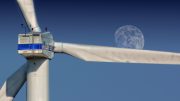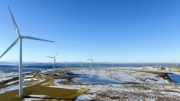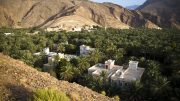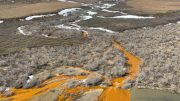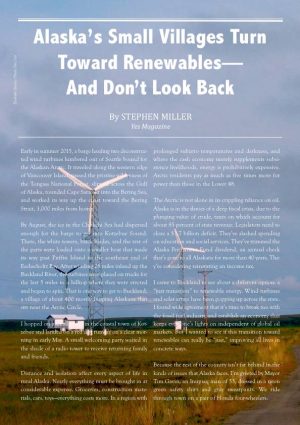 Early in summer 2015, a barge hauling two deconstructed wind turbines lumbered out of Seattle bound for the Alaskan Arctic. It traveled along the western edge of Vancouver Island, passed the pristine wilderness of the Tongass National Forest, slipped across the Gulf of Alaska, rounded Cape Sarichef into the Bering Sea, and worked its way up the coast toward the Bering Strait, 3,000 miles from home.
Early in summer 2015, a barge hauling two deconstructed wind turbines lumbered out of Seattle bound for the Alaskan Arctic. It traveled along the western edge of Vancouver Island, passed the pristine wilderness of the Tongass National Forest, slipped across the Gulf of Alaska, rounded Cape Sarichef into the Bering Sea, and worked its way up the coast toward the Bering Strait, 3,000 miles from home.
By August, the ice in the Chukchi Sea had dispersed enough for the barge to get into Kotzebue Sound. There, the white towers, black blades, and the rest of the parts were loaded onto a smaller boat that made its way past Puffin Island to the southeast end of Eschscholtz Bay. After winding 26 miles inland up the Buckland River, the turbines were placed on trucks for the last 5 miles to a hilltop where they were erected and began to spin. That is one way to get to Buckland, a village of about 400 mostly Inupiaq Alaskans that sits near the Arctic Circle.
I hopped on a small plane in the coastal town of Kotzebue and landed on a red dirt runway on a clear morning in early May. A small welcoming party waited in the shade of a radio tower to receive returning family and friends.
Distance and isolation affect every aspect of life in rural Alaska. Nearly everything must be brought in at considerable expense. Groceries, construction materials, cars, toys—everything costs more. In a region with prolonged subzero temperatures and darkness, and where the cash economy merely supplements subsistence livelihoods, energy is prohibitively expensive. Arctic residents pay as much as five times more for power than those in the Lower 48.
The Arctic is not alone in its crippling reliance on oil. Alaska is in the throes of a deep fiscal crisis, due to the plunging value of crude, taxes on which account for about 85 percent of state revenue. Legislators need to close a $3.7 billion deficit. They’ve slashed spending on education and social services. They’ve trimmed the Alaska Permanent Fund dividend, an annual check that’s gone to all Alaskans for more than 40 years. They’re considering reinstating an income tax.
I came to Buckland to see about a different option: a “just transition” to renewable energy. Wind turbines and solar arrays have been popping up across the state. I found wide agreement that it’s time to break ties with the fossil fuel industry and establish an economy that keeps everyone’s lights on independent of global oil markets. But I wanted to see if this transition toward renewables can really be “just,” improving all lives in concrete ways.
Because the rest of the country isn’t far behind in the kinds of issues that Alaska faces. I’m greeted by Mayor Tim Gavin, an Inupiaq man of 55, dressed in a neon green safety shirt and gray sweatpants. We ride through town on a pair of Honda four-wheelers.
Buckland is quiet this morning. “Village life,” Gavin says with a grin. “Everyone’s up all night and sleeps to noon.” Last night he took his daughters caribou hunting, and brown pelts are draped over a four-wheeler out front. Like the other houses in Buckland, Gavin’s place is single-story, wooden, rectangular, and built on stilts.
It’s the shoulder season. The snow has nearly disappeared from the rolling hills but the tundra has not yet regained its vibrant green. For months out of the year, Buckland sits in the dark and cold. Now, each day adds about nine minutes of light, and the river is breaking up, taking chunks of ice downstream to the Chukchi Sea.
There is a school with about 180 students, a health clinic, and a grocery store where a gallon of milk typically runs around $8 and cigarettes $13. As with most Native villages, there is not much of a cash economy. The sale of homemade wares brings in a bit. Most paid jobs are with the tribe or state government, and these are most often held by women. Men pick up odd jobs and hunt and fish year round.
Hunting may put food on the table, but it doesn’t keep on the lights—or the internet. This morning, one of Gavin’s daughters sings along to a YouTube video on a computer as another scrolls through her iPhone. Gavin’s electricity bill has run as high as $900 a month. That’s expensive, even by Arctic standards; though others in the region pay as high as $600. In the Lower 48, the average is $114. The turbines have helped bring Gavin’s bill down to around $400.
To address cost disparities, Alaska pays a subsidy to rural users who draw less than 500 kilowatt-hours a month. Heavy users, like Gavin and businesses, see the immediate effects of renewables.
To say people here are dependent on oil is an understatement. Even with the turbines, the town relies on five 300-gallon tanks to supply its diesel generators, and each home has its own supply of heating fuel. “We burn through them quick when it’s 40 below,” Gavin says.
Alaska has become a proving ground for sustainable energy; in particular, the microgrid—a small power grid that serves one community in isolation.
Critics argue that renewable energy performs inconsistently, but microgrids mix sources like wind and solar with existing diesel generators. Engineers can manage a grid and keep fossil fuel input to a minimum. The Renewable Energy Alaska Project estimates that efficiency and renewable projects across the state saved 22 million gallons of diesel fuel in 2015 alone—worth nearly $61 million. While the grid does not yet run entirely on renewables, that is now within reach. I had thought I could get to know Alaska’s renewable energy transition by touring Buckland’s renewable energy facilities, but it turns out the real story is more pragmatic.
The first stop is not the wind turbines on the hill, but a state-of-the-art treatment plant that pulls water from the river and filters it using a magnetic process that removes organic matter and inorganic contaminants like iron. There are only a few of these in the state. The facility was built when fuel prices were lower. As the cost of diesel to power the plant rose, residents couldn’t afford their bills and began to default.
“We realized we had a real crisis on our hands,” says Ingemar Mathiasson, energy manager for the Northwest Arctic Borough. He says failing water and sewage systems and $12-a-gallon fuel pushed a coalition that included the borough and tribal corporations to look seriously into energy alternatives.Mathiasson led a feasibility study and inventory of resources that found the region was rich in wind and, perhaps surprisingly, solar potential. Solar can work in the Arctic during the several months of the year when the sun hardly sets. Towns in other parts of the state have also tapped geothermal energy, and communities along the coast can use hydroelectric power. Kodiak, a town of 6,300 at the top of the Aleutian Islands, is the state’s poster child for renewable energy: Wind and hydro generate nearly all its power.
In 2010, the coalition received funding from the federal government’s Coastal Impact Assistance Program. They then began the years-long process to install the 30 solar panels that now reduce the cost of powering the treatment facility, and the two wind turbines west of the village.
It’s early afternoon when Gavin and I make our way up the hill to the two 100-kilowatt wind turbines. It’s a clear day and a parade of clouds casts shadows on the tundra below. It appears endless.
The turbines looming 120 feet above us were developed specifically for the Arctic. Black blades reach out 68 feet from a rotating hub and pivot to make the best use of wind speeds as low as 7 miles per hour and as high as 56. The blades operate well in dense air at extremely low temperatures. On a decently windy day, the turbines can produce about a third of Buckland’s power.
The parts, labor, and 5-mile cable back to town cost about $6.2 million, money the coalition scraped together from federal and state grants. Mathiasson’s research shows that the region, including Buckland, nearby Deering, and the city of Kotzebue—a combined population of fewer than 4,000 people—has saved $4.5 million in diesel fuel since Kotzebue’s wind turbines came online more than a decade ago. Kotzebue has been experimenting with wind in the Arctic since the late 1990s. The village projects are new and relatively small, though planned solar and battery additions will significantly increase their impact.
“The bottom line for rural Alaska is that the more independent we can become from having to import fuel from other places, the more resilient the communities and Alaska as a whole will be,” Mathiasson says.
Buckland and other communities take advantage of every possible energy savings. When the windmills generate more power than is needed, the excess goes to heat water pipes in the treatment plant. Waste heat from the diesel generators is used to warm the city office. In Kotzebue, the electricity co-op uses its waste heat in that city’s hospital. Efficiency is the first step toward sustainability.
Heading back into town, I can’t help noticing yards that spill over with nets, traps, engine parts, steel drums, and all manner of apparent refuse. Anything within reach, however, may still hold some value. Arctic life is a struggle just to get the things one needs. Imagine waiting for the sea to thaw to receive deliveries replacing something that had been thoughtlessly tossed away a season before.
The Inupiaq people of this region were semi-nomadic when Western settlers established towns. They still rely on the land and ocean for their food and living, but the land is changing.
On a projector in a back room of his house, Gavin traces the river’s course via Google Earth. He points out previous Bucklands—abandoned settlements his ancestors inhabited years ago, before the ever-braiding river or changing food sources caused them to relocate. The site of the previous village is within view, across the river where a few weathered wooden structures still cling to the tundra. The Inupiaq keep adapting.
Today, the river is foremost in Gavin’s mind. As long as anyone can remember, the river, swollen by melting snow, begins to break up in early June. The event lasts a couple of days and usually results in an ice dam that floods the village (hence, houses on stilts). But in recent years, the ice has slipped out quietly in May.
“Look!” Gavin says, pointing to a live-feed screen that displays a view of the river. “We’re supposed to be flooding right now, but there ain’t enough snow out there.”
But it’s not really the flooding Gavin’s worried about. At this time in previous years, there would still be enough ice to support a snow machine, allowing hunters and trappers to work their routes. Instead, the river is a slushy mess not strong enough to hold a hunter, not open enough for a boat. Gavin and the others are usually stuck waiting on the banks.
At breakfast the following morning, Oscar Walker drops by for coffee. His wife works for the school district, and he is a subsistence hunter who, unlike Gavin, has shunned the digital age. He prefers the old ways of doing things.
Walker recently learned that his wife has gout. “The doctors want to put her on meds, but I won’t let them,” he says. “They keep you in a cycle where you depend on them for assistance programs to make it easier.” Instead, he’s committed to healing her body by harvesting as much of their food from the land as
That has become more difficult as the ice has dissipated, he says.
In recorded history, there has never been less ice in the Arctic seas than this past year. A biologist with the U.S. Fish and Wildlife Service in Kotzebue put an early end to his team’s study of Chukchi Sea polar bears because the ice had retreated so far north they couldn’t find the animals.
In the spring and fall, the Inupiaq hunt oogruk, or bearded seal. Oogruk rest on shelves of solid ice between dives for mollusks. Hunters use the ice to get within striking distance of a seal. (Hit an oogruk in the water and good luck getting it out.) Poor ice has both diminished the chances hunters will find a seal and increased the difficulty of getting to it if they do.
Gavin and Walker know that these changes are the result of fossil fuel use on a grand scale. If Buckland were to power itself entirely on renewables, the impact on global warming would be negligible. But making that switch would save the community thousands of dollars a year—money that could then be spent at the grocery store to supplement a livelihood that used to come from the land.
Construction of a few wind turbines in Arctic villages won’t stop climate change and can’t undo much of the damage the fossil fuel economy has already done here. But the transition to renewables and microgrids like Buckland’s can provide local economies a measure of control. Energy ownership is crucial to the just transition I came to the Arctic to explore. And this is where Alaska Native tribes are particularly well-positioned to benefit.
Alaska’s tribal system is unique. Tribes were organized into 13 for-profit corporations under the Alaska Native Claims Settlement Act of 1971, an effort to resolve ownership disputes over 44 million acres of land. Tribal corporations, like any other, invest and pass profits on to their shareholders—in this case, tribal members.
Though ANCSA resolved bitter land disputes in a way that empowered Native groups, some criticize it for encouraging tribal corporations to develop resources for profit.
“Sometimes living and thriving on your land is best accomplished without developing the land. But what is your cash economy in rural Alaska if you don’t develop your land?” said Elisabeth Balster Dabney, executive director of the Northern Alaska Environmental Center, which promotes conservation and sustainable resource stewardship in interior and Arctic Alaska. As resource extraction can damage the land on which indigenous cultures depend, tribal leaders looking to bolster their economies face difficult decisions.
Buckland falls within the NANA Regional Corporation, which owns the only hotel in Kotzebue and has investments ranging from an oil company in the Gulf of Mexico to the town’s grocery store. Profits from these ventures are paid to Inupiaq members as a dividend, as are those generated by the energy co-op. This model localizes economic investment and keeps cash in the community.
“The only sustainable future is harvesting energy as close to home as you can,” Mathiasson says. “By harvesting energy locally, you’re also creating a local workforce, and that money stays in the communities instead of being part of the diesel fuel equation.”
That’s not to say these small renewable grids are sizeable employers. Buckland sent two workers to Anchorage for training on the new systems and as line technicians to handle outages and other issues.
Buckland, Deering, and Kotzebue will add solar arrays and new batteries in 2018. The towns can then run almost entirely on renewables for half the year, and supplement with wind power year round. As these systems expand throughout the region, more technical positions will become available, with preference for local hires. The North Slope oil industry, in contrast, hires nearly 40 percent of its workforce from outside the state.
For most people, a better future is about economics.
Fisheries built towns up and down the coast, and the Klondike gold rush brought tens of thousands of eager prospectors, but nothing transformed Alaska like the oil industry. The state’s first oil well was drilled in 1902, and at the peak in 1988, oil companies pumped 2 million barrels of crude a day. When the oil money was flowing, it built Alaska’s schools, hospitals, roads, and bridges and established the Alaska Permanent Fund—the world’s only universal basic income program.
Now that the price of oil has plummeted, that money no longer fills the state treasury. And though industry investors are seeing profits decline, it is state residents who must live with the long-term effects.
“The oil companies are not committed to the long haul, and Native people are paying the price as their hunting and fishing get destroyed,” says Enei Begaye, a Navajo woman who directs the indigenous rights advocacy group Native Movement in Fairbanks.
In the past when the economy slumped, state lawmakers responded by calling to expand drilling, to get oil flowing through the pipeline again. But the latest bust even has conservative residents doubting the economic strategy of “drill, baby, drill.”
“The oil companies like to push the narrative that Alaskans want more oil development, but that’s not true,” Begaye says. “Nothing will replace the oil money,” and never again will the state see such profits. “If we just think about how much money we can make, we’re missing out on what an economy can be.”
The question I brought to the Arctic was whether this oil low point, coupled with the effects of climate change in a state proud of its wild beauty, is enough to tip the scale toward a new way of thinking.
Only a few of those I spoke to had even heard of the “just transition” movement. People here focus on more immediate, practical issues—but that’s why renewable energy is winning. It makes economic sense.
The microgrid technology has been proven, and costs are coming down. One important lesson for the Lower 48 is the need for political will. None of this transformation would exist without significant government investment, and the current fiscal crisis has brought many plans to a halt.
For the transition to continue, Alaska’s legislators will need to get fully on board. Though the state has weathered economic downturns before, it hasn’t had to do so with billions of dollars of infrastructure fixes necessitated by melting permafrost. It hasn’t done so while ocean acidification threatens its fishing industry. And it hasn’t done so at a time when renewable energy sources can outcompete oil.
“Renewables are growing,” Mathiasson says. “I think the grassroots level is strong enough; the people want a cleaner energy source, and they want to see a better future.”
Stephen Miller
Originally published
by YES Magazine
August 25, 2017


